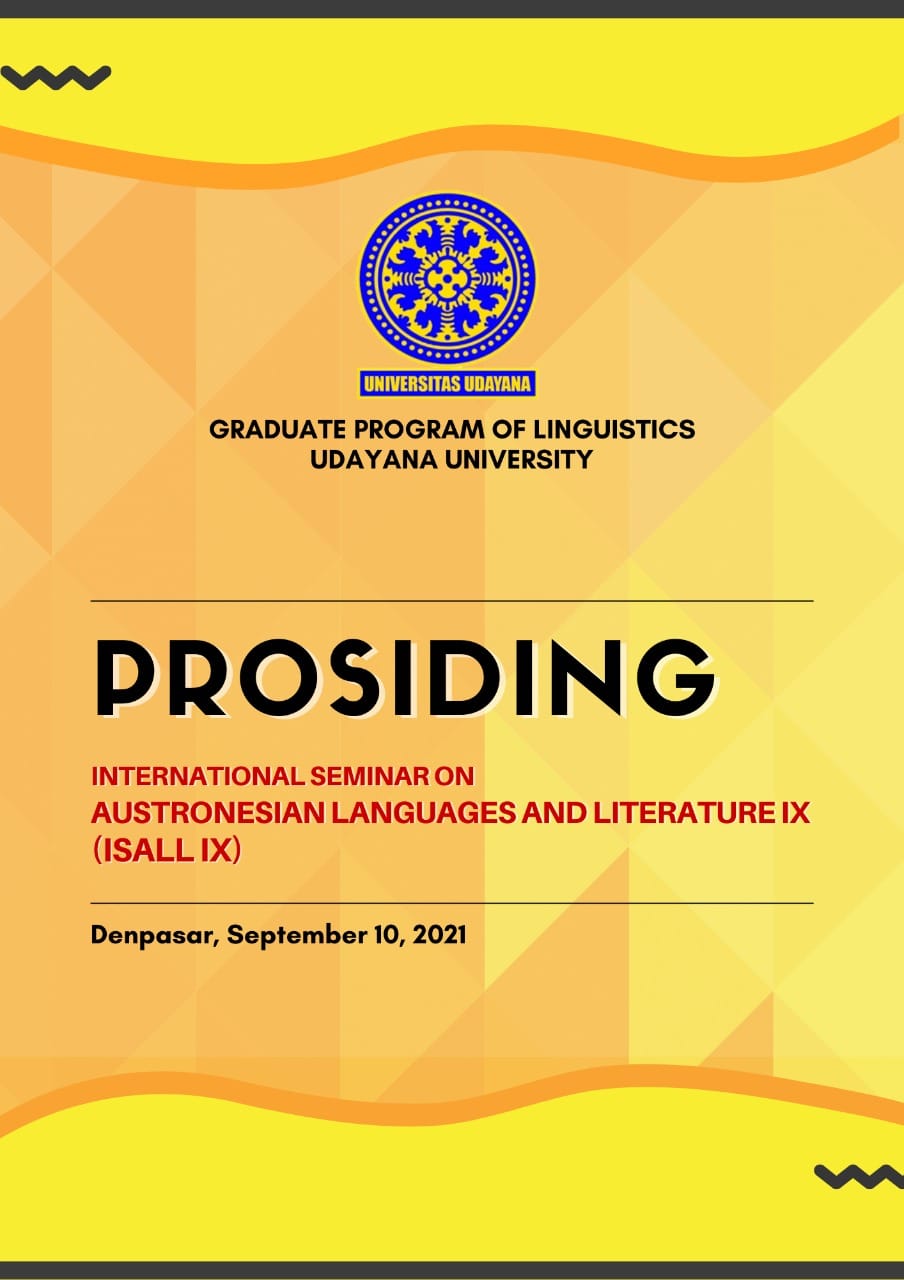Implementasi Kebijakan Bahasa Bali Dalam Penggunaan Tanda Bahasa di Ruang Publik
Abstract
The rapid development of multiculturalism and multilingualism along with the growth of tourism in Bali has greatly contributed to the decline number of Balinese languages speakers. Therefore, in order to empower and promote the sustainable use of the Balinese language and script, the government issued a policy through: Bali Governor Regulation Number 80 of 2018 (Balinese Language Policy). This study discusses the implementation of the Balinese Language Policy in the use of language sign in public spaces, as well-known as Linguistic Landscape (LL). Specifically, the discussion refers to Balinese Language Policy Article 6 paragraph (1) which requires the use of Balinese script above Latin letters in writing names of Hindu places of worship, traditional institutions, inscriptions marking the inauguration of buildings, government institution buildings, private institutions, streets, tourism facilities, and other public facilities. This study conducts qualitative-descriptive method with research procedures, namely an empirical survey of language signs in public spaces, classification of language signs, and analysis of the implementation of Balinese Language Policy on language signs in public spaces. In the analysis of language signs in Balinese LL, signs are classified into ‘public signs’ and ‘personal signs’. Based on the data analysis, it was found that the Balinese Language Policy was implemented effectively in accordance with the policy on public signs. On the contrary, the implementation of the policy on personal signs did not go as effectively as that of the public signs because there were only a small number of people who implemented the policy
References
Appadurai, A. (1990). ‘Disjuncture and Difference in the Global Cultural Economy.’ Theory, Culture and Society, 7(2-3): 295–310.
Aronin, L. & Laoire, M. O. (2012). ‘The material culture of multilingualism.’ Dalam: D. Gorter, H. F. Marten & L. Van Mensel (ed.). Minority Languages in the Linguistic Landscape (halaman. 299-318). London: Palgrave-Macmillan.
Artawa, K. & Sartini, N. W. (2019). ‘Linguistic landscapes: A study of human mobility and identity change.’ Dalam: Kerr, dkk. (Ed.). Urban Studies: Border and Mobility (halaman. 165-172). London: Taylor & Francis Group.
Backhaus, P. (2007). Linguistic Landscapes. A Comparative Study of Urban Multilingualism in Tokyo. Toronto: Multilingual Matters Ltd.
Barni, M., & Vedovelli, M. (2012). ‘Linguistic landscapes and language policies.’ Dalam: C. Helot, M. Barni, R. Janssens, & C. Bagna (Ed.). Linguistic Landscapes, multilingualism and social change (halaman. 27–38). Frankfurt: Peter Lang.
Ben-Rafael, E., & Ben-Rafael, M. (2015). ‘Linguistic Landscapes in an Era of Multiple Globalization.’ Linguistic Landscape, 1(1/2): 19–37.
Ben-Said, S. & Kasanga, L. A. (2016). ‘The discourse of protest: frame of identity, intertextuality and interdiscursivity.’ Dalam: R. Blackwood, Lanza, E. dan H.
Woldemariam (ed.). Negotiating and Contesting Identities in Linguistic Landscapes. London: Bloomsbury Publishing.
Eberhard, David M., Gary F., Simons & Charles D. F. (2019). Ethnologue: Languages of the World. Twenty-second edition. Dallas, Texas: SIL International. Online version: http://www.ethnologue.com.
Gorter, D. (2006). ‘Introduction: the study of the linguistic landscape as a new approach to multilingualism. Dalam: D. Gorter (Ed.). Linguistic Landscape: A New Approach to Multilingualism (halaman. 1-6). Clevedon–Buffalo–Toronto: Multilingual Matters LTD.
Gorter, D. (2013). ‘Linguistic Landscapes in a Multilingual World.’ Annual Review of Applied Linguistics, 33(2013): 190-212.
Gorter, D. (2018). ‘Methods and techniques for linguistic landscape research: About definitions, core issues and technological innovations.’ Pre-final version in Putz & Mundt 2018.
Landry, R. & Bourhis, R. Y. (1997). ‘Linguistic landscape and ethnolinguistic vitality: An empirical study.’ Journal of Language and Social Psychology, 16(1): 23-49.
Leeman, J., & Modan, G. (2009). ‘Commodified language in Chinatown: A contextualized approach to linguistic landscape.’ Journal of Sociolinguistics, 13: 332–362.
Malinowski, D. (2009). ‘Authorship in the linguistic landscape: A multimodal -performative view.’ Dalam: E. Shohamy & D. Gorter (Ed.). Linguistic Landscape: Expanding the Scenery (halaman. 107–126). London: Routledge.
Monnier, D. (1989). ‘Langue d’accueil et langue de service dans les commerces à Montréal.’ Québec: Conseil supérieur de la langue française.
Mustika, I. K. (2018). ‘Pergeseran Bahasa Bali sebagai Bahasa Ibu di Era Global (Kajian Pemertahanan Bahasa).’ Purwadita, 2(1): 94-102.
Rosenbaum, Y., Nadel, E., Cooper, R. L. & Fishman, J. A. (1977). ‘English on Keren Kayemet Street.’ Dalam: J. A. Fishman, R. L. Cooper dan A. W. Conrad (ed.). The Spread of English (halaman. 179-196).
Rubdy, R. & Ben Said, S. (2015). Conflict, Exclusion and Dissent in the Linguistic Landscape. Basingstoke: Palgrave MacMillan.
Shohamy, E. (2015). LL research as expanding language and language policy.’ Linguistic Landscape: An International Journal, 1(1-2): 152-171.
Shohamy, E. (2006). Language Policy: Hidden Agendas and New Approaches. New York: Routledge. https://doi.org/10.4324/9780203387962.
Sutama, I. M & Suandi, I. N. (2001). Loyalitas-Bahasa Penutur Bahasa Bali terhadap Bahasanya. Laporan Penelitian Universitas Udayana. Bali: Universitas Udayana.
Tulp, S. M. (1978). ‘Reklame en tweetaligheid: Een onderzoek naar de geografische verspre- iding van franstalige en nederlandstalige affiches in Brussel.’ Taal En Sociale Inegratie, 1: 261-288.
Wenzel, V. (1998). ‘Reklame en tweetaligheid in Brussel: Een empirisch onderzoek naar de spreiding van Nederlandstalige en Franstalige affiches.’ Dalam: Vrije Universiteit Brussel (ed.). Brusselse Thema’s 3 (halaman. 45-74). Brussels: VUB.
Vandenbroucke, M. (2015). ‘Language visibility, functionality and meaning across various Time Space scales in Brussels’ multilingual landscapes.’ Journal of Multilingual and Multicultural Development, 36(2): 163–181.
Yendra & Artawa, K. (2020). Lanskap Linguistik: Pengenalan, Pemaparan, dan Aplikasi. Yogjakarta: Deepublish.


